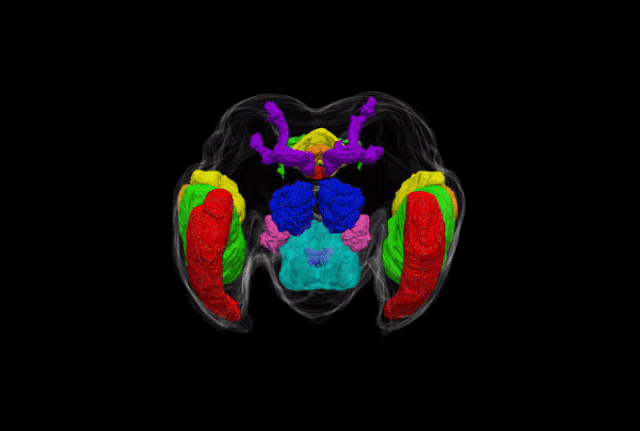https://gadgtecs.com/wp-content/uploads/2018/03/Mosquito-Brains-FrontView.png
Researchers have constructed the first neuroanatomy atlas of a female mosquito’s brain.
GIF image (5.84 mb)
MP4 (0.8mb)
A reconstruction of a female Aedes aegypti brain reveals distinct brain areas that connect to and communicate with each other to orchestrate mosquito behaviors.
A mosquito’s head is about the size of a pen tip, but it packs a dangerous punch: it is the delivery system for yellow fever, malaria, and Zika, among other blood-borne diseases. In most mosquito species, females are the more dangerous ones. They are the ones sucking – and transferring – blood.
Researchers at Howard Hughes Medical Institute (HHMI) have mapped the neuroanatomical areas of the brain of a female mosquito (Aedes aegypti). The researchers constructed the map of groups of neurons by immunostaining the mosquito’s brain for Brp, a synaptic protein, and imaged the brain with confocal microscopy. The atlas was made freely accessible online on 31st January 2018.
“Somewhere in that female brain is the drive to sense humans, fly toward humans, land on humans, and bite and drink the blood of humans, Somewhere in that brain is where decision making, motivation, and hunger reside.”
You May Like: Engineers create plants that glow using nanoparticles
“We are trying to construct the field of mosquito neurobiology,” says HHMI neurobiologist Leslie Vosshall, who led the work. She says she hopes that the new atlas will let mosquito researchers from all over the world share information and better understand which elements of the mosquito brain direct different behaviors.
[caption id="attachment_3284" align="aligncenter" width="700"]
 A female aedes aegypti mosquito feeding on blood. Credit: Alex Wild Photography[/caption]
A female aedes aegypti mosquito feeding on blood. Credit: Alex Wild Photography[/caption]Tags: #science #neuroscience #neuroimaging #tech #neurobiology #technology #mosquitoes #mosquito #microscopy #microscope #imaging #biology #bio #blood #suckers #imageoftheday #imageoftheweek #picoftheday #picoftheweek
Source: Men Younger / Howard Hughes Medical Institute / Rockefeller University
https://gadgtecs.com/2018/03/07/3279/
Comments
Post a Comment